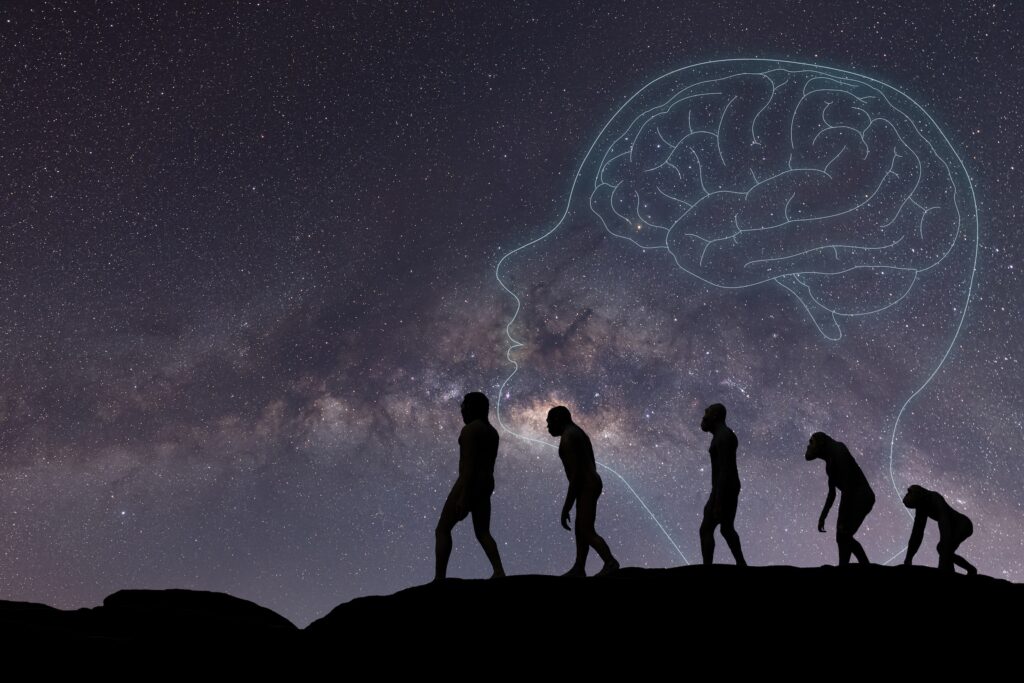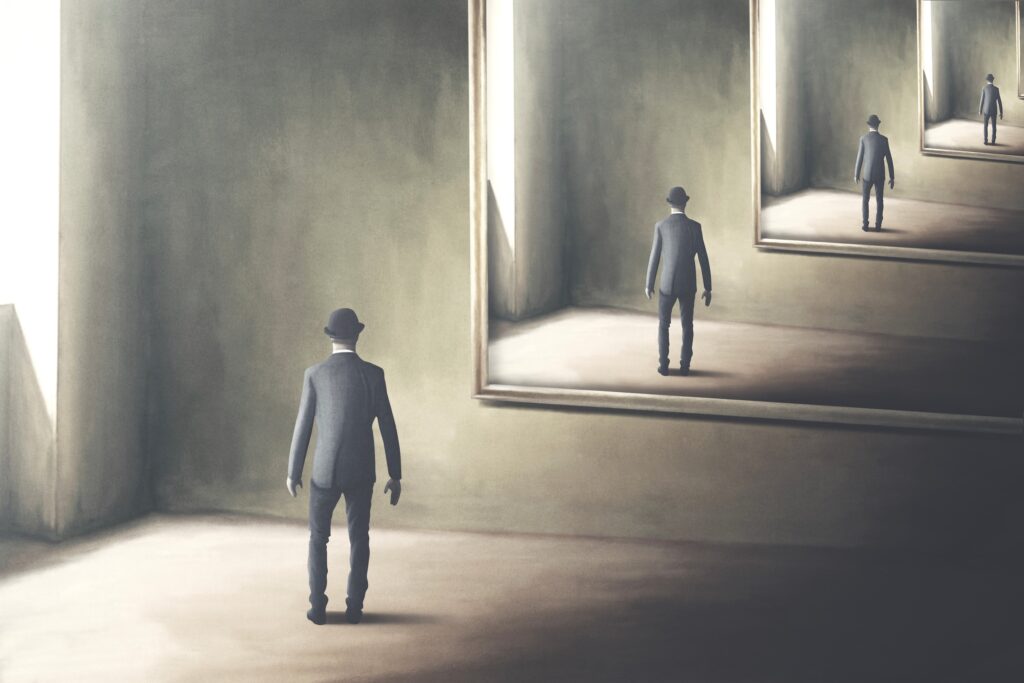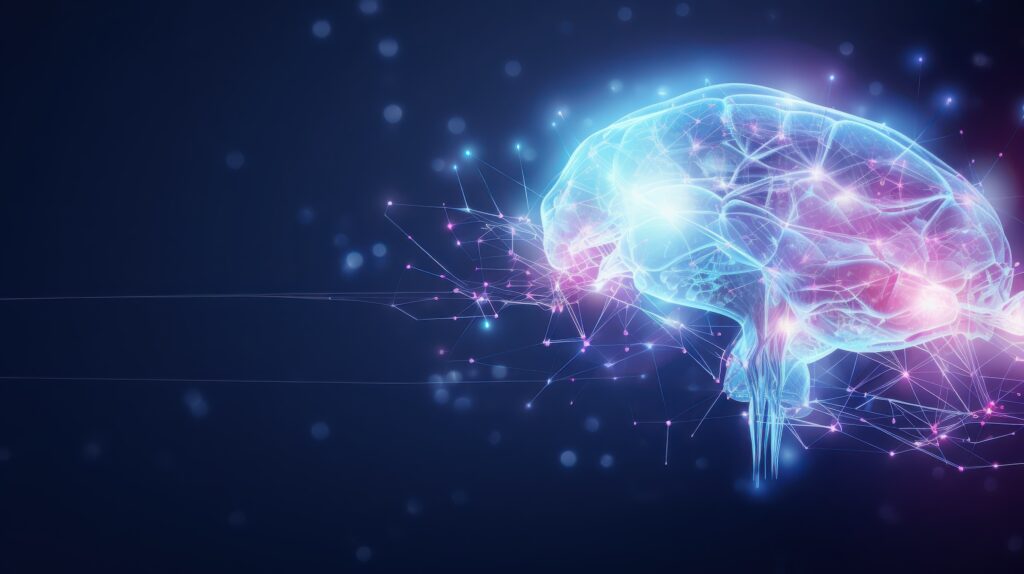The subject beyond the ‘I’: On structural psychoanalysis
Reading | Psychology
![]() Dr. Ludwig Sachs | 2023-05-28
Dr. Ludwig Sachs | 2023-05-28

A careful investigation of our phenomenal inner life reveals a self indistinguishable from the world and others, and yet impossibly beyond both, argues Dr. Sachs. This realization constitutes a challenge to our need to self-actualize as individuals, with significant psychological (and perhaps even metaphysical) implications.
The challenge of this article will be to create an awareness of the unconscious from the perspective of structural psychoanalysis, which was developed by the French psychiatrist Jacques Lacan1 in the 20th century based on the insights of Sigmund Freud. Ideally, it should also be visually appealing, so to cater to modern vision-oriented sensitivities.
But is it not an impossible task to try to illustrate unconscious structures in any way? Yes, it is! We literally see this impossibility of visualization every day, if we just look closely. And precisely because of this paradoxical circumstance, we can almost ‘see’ the unconscious.
The three registers of structural psychoanalysis
Look around you; what do you see? You naturally assume that objects are out there and that you, as an ‘I,’ a human observer with a body, are somehow ‘in your head,’ at a certain distance from the objects. If you’re outside or looking out the window, you may see the blue sky. You know and have learned that you are on Earth, surrounded in all directions by the vastness of the universe, along with your fellow human beings and other living creatures. You also know, of course, that you and everything else exist in a three-dimensional space, which surrounds you and in which you can move. You can simply turn around and see the space that was just behind you, and when you turn back in the original direction, you see the same space again. Perhaps you also have a mirror nearby, in which your body, your ‘I,’ can be reflected. And while you see all of this out there, a certain amount of time passes, which runs independently of you, just as the objects around you and the space in which you move exist independently of you. With this familiar, pictorial conception of space, time and self-consciousness, we have just described the first of three registers or orders of structural psychoanalysis: the Imaginary.
Next step: the things out there will mean something to you. The whole situation is part of your life story and somehow it all relates to you; maybe it even makes sense to you. You can tell your life story using the language you have been taught. You have also been taught what the words and sounds of that language mean. So, the objects out there have names and meanings for you: table, wall, window, magazine, laptop, light, sky, tree, etc. These words, in turn, have further meanings that can be explained with words, which themselves have meanings that can be explained with further words, and so on. For you to be understood, you must follow rules when speaking. In general, everything you see out there seems to be subject to order and structure. Some of these structures may also be hidden or not fully accessible to our descriptions. And yet, what is subject to these orders and laws apparently does not have to be aware of this order itself. One could say that nature has a knowledge of the laws of nature while not being aware of them.
We, too, obey the laws of nature without having to know them. We are subject to the reference system of designations and meanings described above, without knowing its endless network. It is therefore a knowledge of which one is not aware: an unconscious knowledge. There are structures and laws in societies and interpersonal relationships, in living beings, nature, and matter, but also in language, with which we can then speak about these structures. Structural psychoanalysis calls these never-ending structures of words, designations and meanings, which in turn create words, designations and meanings, the Symbolic.
Let’s take a step further. Forget for a moment what you think you know about your situation in space and time, the structure and functioning of your eyes, your brain, and so on. Look again closely. What do you really see? What do you perceive when you simply describe what appears in your consciousness? In front of you, you see an image that looks like a space with certain things in it. But what is behind you? Can you see it without turning around? It is neither dark nor bright, it is simply not conscious to you. Only when you turn around can you observe this image and become aware of it. But what is there before that?
Now imagine that you might not actually be in a three-dimensional space that exists independently of you. After all, you don’t see space as a whole, from all sides. Stay with what you really perceive, not what you supposedly know. As a first approximation, you might imagine that you are in a dark room and your eyes are like flashlights that only illuminate a part of the darkness. What lies in the darkness before you look remains hidden from you. Perhaps the image of space only arises in the moment you look or direct your consciousness towards it. At least this idea would correspond more to what you perceive: an image in front of you that becomes blurrier towards the edges, and behind you, in the dark, a ‘nothing’ or a ‘something’ that is not conscious to you.
But is it really true that there is a front and a back? Or an inside and an outside? And am ‘I’ really in between front and back? Or inside? Let’s take a closer look.
Forget for a moment what you think you know about your body in space, optics, the structure of your eyes, and so on, and assume that you have no problems with seeing. Then the image that appears in front of you is reasonably sharp in the center, directly opposite you, and becomes less clear, less sharp and blurred towards the edge. In contrast to the edge of the image, you can focus on individual objects in the center and thus isolate them from the overall image. One could also say: your ‘I’ is in the center facing the isolated object. If you look at the image more closely, you will also notice something peculiar: the image converges exactly to this center. You can observe this particularly well if you position yourself exactly in line with an elongated object, such as a straight path or the end of a long table. No matter where you look, there is always a central point in the distance, a point towards which everything seems to converge, exactly opposite you.
But wait a minute; that’s strange: ‘I’ should actually be the center of my perception, the (central) point from which I perceive space and the image, not that point over there, in the distance! Why does the image always center there, exactly opposite my ‘I’?
Stay with your perception, not what you think you know about distances and optics. So, if the image converges at that point over there, and not here, then maybe ‘I’ am not really where I thought I was. ‘I’ am actually another—another point, not here, but over there!
But then isn’t inside also outside? Isn’t here and there actually one point, which converges with the one in the distance, in infinity? A place where ‘I’ repeatedly face different objects? And what about the ‘I’ of others? Doesn’t that also mean that we are all one ‘I,’ at the same point, in the same place, in the same hole? But that’s impossible! And with this somewhat frightening approach to the impossible, we have experienced the third register of structural psychoanalysis: the Real.
The three registers or orders (the Real, Symbolic, and Imaginary, abbreviated as RSI) are not independent of each other but, from a psychoanalytic perspective, are interconnected like the so-called Borromean Rings. These three rings are so interconnected that their links fall apart when one ring is opened. In an analogous manner, all human experiences irretrievably disintegrate into this RSI structure.
Given these frightening impossibilities and abyssal infinities, you will quickly retreat into your habitual conception of space, time and self-consciousness, that is, into the Imaginary, using your psychological defense mechanisms. But try to linger for a moment with these paradoxes and impossibilities. What does all this mean? Can it also be visualized?
The human—in psychoanalytic terminology, the subject—is apparently decentered. One might say, ‘I’ am not where I actually am, where I myself am; in a sense, ‘I’ and ‘self’ are disconnected. Let’s stay in the visual field to illustrate this again. We must focus only on what we really see and set aside our beloved knowledge for a moment. Can you see yourself when you see? No, you cannot see yourself. You may see parts of your body, your legs, arms, etc., but all of these are only objective parts of you, not yourself. Usually, one would say, “I have arms, legs, etc.,” and not “I am arms, legs, etc.” But perhaps we can see ourselves through detours? For example, you could stand in front of a mirror to see your reflection. But that is not you either! That is only your reflection, an image that you identify with and say, “That’s me!” So ‘I’ am actually someone else. And when you are standing in front of a mirror, very close to the mirror, do you see what gradually emerges there, in your pupil, in this black ‘hole’? What is looking at you from the darkness, from within you, from this hole? What appears when you want to see yourself very clearly? Your reflection! I am someone else! And in that person’s eyes, your reflection appears again, in which you are reflected again, and so on.
So ‘I’ am condemned to be someone else. Again and again, facing other objects, reflecting in them to reflect them, trying in vain to fill the hole in the same place, this impossibility; the hole in the same place where I cannot be myself; an infinite mirror cabinet without ever coming to myself.
How did we come to this inherent sense of lack? What traumatic event assailed us in our past? Is there perhaps a story about it? Yes, there is. Most people will know it. This story has been told since ancient times, whispered from generation to generation, to tell of the unimaginable, the trauma of humanity in distant times.
Once upon a time, people were completely themselves and one with what made them whole and holy. So they lived in peace with themselves and in harmony with life, and knew the word and name of everything alive. But then the unthinkable happened, a traumatic experience so terrible that humans had to repress the memory of it for all time. It was said to be a fatal mistake, a great guilt that humanity took upon itself. And so humans were banished and expelled from themselves. Since then, one wanders through space and time like Isis in search of the dismembered Osiris, hoping for redemption, driven by an unconscious knowledge to find the lost and remedy the lack.
The unconscious is structured like a language
Humans are characterized by an insurmountable lack. This lack of being is referred to as the splitting/dissociation of the subject and is constitutive of human existence. This means that the subject is not capable of grasping itself or being itself, but only ever being another. The split leads to the fact that the subject has no access to a part of itself. This part, which Freud called the unconscious, is however indispensable for the constitution of the subject and its psychic structure. Paradoxically, the human subject can only constitute itself as a subject through its split or dissociation.
The split or dissociation of the human subject is based on a traumatic experience that is fundamental to human existence. However, this experience has been irreversibly repressed and was referred to by Freud as Urverdrängung, the primal repression. The primal repression remains unconscious and cannot be interpreted, therefore it makes no sense.
Structural psychoanalysis regards the split of the subject to be a consequence of its submission to language. The subject is not language itself but arises through the loss or lack that language brings about. The linguistic structures that constitute the subject are called signifiers. Unlike a sign, the signifier does not simply represent something for someone, but is what represents the subject for another signifier. In short, the subject is represented by the relationship between signifiers.
Thus, structural psychoanalysis does not describe the subject as being characterized by a particular meaning, but rather by an infinite referral of meaning and significance. This referral structure is called the Symbolic and consists of an infinite, mostly unconscious structure of designations and meanings. Structural psychoanalysis calls the elements of this structure signifiers, which means that the transitions between them are discontinuous, i.e., abrupt or discrete; in the language of quantum physics: quantized, rather than continuous.
Structural psychoanalysis asserts that the signifiers influence and transform the subject’s natural needs into the so-called signified: the designated or object of meaning. It postulates the primacy of the signifier over the signified, a concept that was adopted by the French ethnologist and anthropologist Claude Lévi-Strauss. This means that the signifying element precedes the signified and that the signified cannot exist independently of the signifying element.
The transformation of needs by the signifier has an overall effect: the lack. In psychoanalytic theory, this lack is symbolized by the phallus signifier. Therefore, the subject has an interest, a desire, a longing for the signified, i.e., the object of meaning.
The chaining of signifiers creates a dynamic of lack and desire that refers back to itself without coming to a halt, without coming to itself. This iterative, self-referential search leads to emergence, self-similarity and self-organization, or fractal patterns/geometries as observed in complex systems.
This dynamic arises from the fact that the signifier is not identical with itself; instead, it is always distinguished from itself. Therefore, the signifier cannot repeat its original meaning. However, the subject desires to rediscover the original meaning, that is, ‘itself,’ since it is represented by the relationships between the signifiers. Consequently, the signifier is repeated, and only through this repetition—which must occur at least once—does it become a signifier at all. Nonetheless, the repetition is futile because the same thing is impossible due to the marking of the subject by the signifiers. Hence, the repetition is repeated again, creating an endless loop of repetitions.
Structural psychoanalysis refers to this impossibility, that which is impossible to symbolize, as the Real. The Real is the traumatic, the causeless, the unfathomable, and the logically impossible, which cannot be imagined or symbolized. The Real is also what ‘keeps coming back in the same place.’
The Real can also be found in the sciences, where in every formalized, symbolized field, such as mathematics, logic, or physics, there are areas that cannot be proven but must still serve as a basis. In these areas of knowledge, the Real functions as an axiom. The Real can also be accessible through logical contradictions that may arise during formalization. In quantum physics, the Real manifests itself as a random event. And in psychoanalysis, it appears at the points where the procedure of free association and interpretation fails.
The Phantasm
Imaginary objects serve as illusory compensations for the subject’s unconscious lack of being. In psychoanalytic terminology, the subject split/barred by signifiers desires an object. This object designates and represents what is missing and is therefore desired by the subject. The search for the object in physics can thus be understood as a prototypical expression of this desire.
These objects have an imaginary character, as they are oriented towards the idealized body image. Structural psychoanalysis calls the order of the body image the Imaginary. By referring to the idealized, closed and unitary image of the body, the split subject can conceive of itself as an imaginary unity, as the ‘I.’ We rely on this ideal of wholeness. It is necessary for us to mask our fragmentation/dissociation, which we could not bear.
The ‘I’ is the representation of oneself as a body or consists in the identification with the image of one’s own body. This identification process—i.e., the consciousness of the ‘I’—can be impaired, as in the case of depersonalization or out-of-body experiences. As a simple experiment, the so-called rubber hand illusion2 can be performed, in which one can experience an illusory spatial localization of the subject. This has been experimentally demonstrated by the philosopher and neuroscientist Thomas Metzinger.3
The relationship to the body image also structures our relationship to space, by orienting ourselves towards the opposition of inside and outside. This is also reflected in physical concepts, such as closed systems and internal/external observers. Freud initially described the psychological apparatus as a kind of sphere, in which the ‘I’ is structured as a modified surface of the id, shaped by the influence of the external world.
Structural psychoanalysis revised Freud’s concept of space in order to reduce the attachment to the Imaginary. Here, the spatial structure of the psyche is no longer viewed from the surface of a sphere, but is examined using topologies such as the torus, the Klein bottle, and the projective plane/sphere with a cross-cap, in order to critically question the imaginary inside/outside opposition. It is important to note that structural psychoanalysis does not view the topological structure as a mere metaphor, but instead understands the structures of the subject as the topological structure.
In topological structures that have self-referential properties, the Real becomes more apparent than in (imaginary) everyday life. The circle is the geometric paradigm for such a structure because, as we imaginarily draw a line to form a circle, we know that the line refers to itself from the beginning: the curve should close in the end, going back to where it started.
However, the circle is fraught with impossibilities that manifest themselves mathematically, as the Real, in the form of the impossibility of squaring the circle, as well as the transcendental number pi—the ratio between the circle’s perimeter and diameter—that encompasses an infinite sequence of digits, thereby being impossible to pin down with complete precision. That is why psychoanalysis does not illustrate the futile attempt to return to oneself as a circle.
Another example is prime numbers, i.e., numbers that are only divisible by one and themselves. From a psychoanalytic perspective, dividing by oneself is only possible imaginarily, because a repetition of the same is impossible.
The unity of the subject is only possible imaginarily, which is represented mathematically as the imaginary unit i: the impossible square-root of -1 in the space of complex numbers. And so the subject circulates in that space between the missing (the zero) and the unattainable unity (the whole number 1). The process unfolds around a center, namely the object of desire, which is lost and impossible to find, thus lying in the Real. In that center, prime numbers arise with every circling attempt to return to oneself. But they are impossible in terms of complete self-congruence and therefore lie in the Real, outside the number space. They can only be written imaginarily, in a continuous way of futile repetition.
Therefore, a purely symbolic, i.e., mathematical description cannot advance further here. A more comprehensive, holistic view is necessary, called a ‘biopsychosocial’ view in psychosomatic medicine.
The Apprentices of Sais
It remains to be hoped that “sisters of deep structures,” such as mathematics and psychology, will one day come together again and allow us to understand the mysterious cipher script that Novalis speaks of in The Apprentices of Sais:
Manifold are the paths people take. Whoever pursues and compares them will see strange figures emerge; figures that seem to belong to that great cipher script that one sees everywhere, on wings, eggshells, in clouds, snow, crystals, and rock formations, on freezing waters, inside and outside of mountains, in plants, animals, humans, in the lights of the heavens, on touched and stroked pieces of pitch and glass, in filings around a magnet, and in strange conjunctions of chance. In them, one senses the key to this miraculous script, its grammar…
Notes
- e.g. https://www.lacanonline.com/ or https://lacan-entziffern.de/ (German)
- e.g. Youtube https://youtu.be/xdxlT68ygt8
- Lenggenhager B, Tadi T, Metzinger T, Blanke O. Video ergo sum: manipulating bodily self-consciousness. Science. 2007 Aug 24; 317 (5841): 1096-9. doi: 10.1126/science.1143439. PMID: 17717189.

Essentia Foundation communicates, in an accessible but rigorous manner, the latest results in science and philosophy that point to the mental nature of reality. We are committed to strict, academic-level curation of the material we publish.
Recently published
Reading
Essays
Seeing
Videos
Let us build the future of our culture together
Essentia Foundation is a registered non-profit committed to making its content as accessible as possible. Therefore, we depend on contributions from people like you to continue to do our work. There are many ways to contribute.















